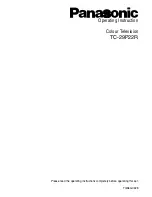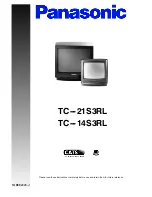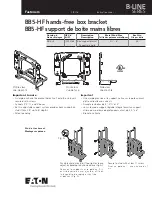
Circuit Descriptions, Abbreviation List, and IC Data Sheets
EN 127
Q528.1E LA
9.
9.4
On-board DC/DC Converters
In this platform, on-board DC/DC converters have been
foreseen. See also diagrams B02A, B02B and B02C.
9.4.1
P
S
U
S
tart-up
S
equence
1.
If the input voltage of the DC/DC converters is around 12 V
(measured on the decoupling capacitors 2U01/2U02/
2U93) and the ENABLE signals are "low" (active), then the
output voltages should have their normal values.
2.
First, the Stand-by Processor activates the +1V2 supply
(via ENABLE-1V2).
3.
Then, after this voltage becomes present and is detected
OK (about 100 ms), the other voltage of +3V3 will be
activated (via ENABLE-3V3).
4.
The current consumption of controller IC 7U00 is around 20
mA (that means around 200 mV drop voltage across
resistor 3U01).
9.4.2
+12V
S
witch
•
The +12V switch is activated when the POD-MODE signal
is "low".
•
The rise time of the output voltage is set by components
2U12, 3U42, and 3U64 and is about 30 ms.
•
The switch "off" is fast, because there can be fault currents
that must be interrupted.
•
When the input voltage (+12VS) is higher than 12.6 V, the
switch is disabled via circuit 6U01, 3U09, 3U18, 2U14, and
7U14-2.
9.4.3
Internal Protection
•
Provides a SUPPLY-FAULT signal (active "low"), when the
output voltage of any DC/DC converter is out of its limits (
±
10% of the normal value). In such cases, the Stand-by
Processor will immediately stop the supplies by sending a
"high" control signal towards the external and internal
supplies: ENABLE-xVx, POD-MODE, ON-MODE, and
STAND-BY.
Note:
The SUPPLY-FAULT control signal is "low" when
any DC/DC converter is disabled by its control signal
(ENABLE-xVx) and +12VSW is present, therefore it is
ignored during start-up!
•
The internal protection works together with the output over-
voltage detector transistors 7U15-1, 7U15-2, 7U29-1, and
7U29-2.
9.4.4
1.2V and 3.3V DC/DC Converters
Introduction
The circuit used is a so-called "synchronous buck converter".
Some characteristics:
•
Switching frequency: approx. 250 kHz.
•
Efficiency: approx. 90%.
•
Built-in output over-voltage and over-current protections
•
Soft start.
•
Software controlled “on/off” (via ENABLE line).
Block diagram
Figure 9-6 Block diagram synchronous buck converter.
The advantage of a "synchronous buck converter" over a
"classical buck converter" is its better efficiency (about 90%).
The difference between the two is that in a synchronous buck
converter the "low -side" diode is replaced by a MOSFET TS2
(item 7U03). This, because the voltage drop across a MOSFET
is smaller than the forward voltage drop of a diode.
This second MOSFET TS2 conducts current during the "off"
times of the first MOSFET TS1 (item 7U01 at the input side).
The upper MOSFET TS1 conducts, to transfer energy from the
input to the inductor L
1
and load R
L
, while the lower MOSFET
TS2 conducts to circulate the inductor current (free wheel). The
synchronous PWM control block regulates the output voltage
by modulating the conduction intervals of the upper and lower
MOSFETs.
PWM Generator and MOSFET Drivers
This circuit is a one-chip solution (item 7U00). It contains all the
circuitry for two independent buck regulators (3V3 and 1V2).
The MOSFETs 7U01, 7U06, 7U03 and 7U08 are the switching
transistors, they are conducting alternatively.
•
Time sequence 1: 7U01/7U06 is conducting; energy is
stored in coil 5U01/5U02. The current is flowing from the
+12VSW power supply source.
•
Time sequence 2: 7U01/7U06 is blocked; energy is stored
in coil 5U01/5U02.
•
Time sequence 3: 7U03/7U08 is conducting, and the
current circuit is now closed via 7U03/7U06, 5U01, 5U02,
2U09/2U94/2U21/2U90/2U921/2U92, and the load. So the
energy stored in the coil during time sequence T1 is
consumed during sequence T3. The signal on the gate
7U03/7U08 is 180 degrees turned compared with the
signal on the gate 7U01/7U06.
Voltage Booster
This circuit is build around capacitors 2U29 and 2U26, resistor
3U62/3UA1, diodes 6U06 and 6U04, and transistor 7U07.
It generates the +18 V boost voltage on pin 4 of item 7U00, to
drive the "high-side" power MOS-FET 7U01/7U06. The voltage
is generated only during normal operation of the converter;
therefore, any drop in its value means an internal fault
condition, which is sensed by the internal protection circuit.
The AC component of the voltage on the source of transistor
7U01/7U06 is rectified by the diodes and added to the input
voltage, resulting into the boost voltage. The resistor 3U62/
3UA1 limits the peak current through the rectifier diodes.
Over-current Detection
Over-current detection is done via components 3U33, 3U26,
3U27, 3U31, and 2U18 for the 3.3 V converter and 3U43, 3U36,
3U37, 3U40, and 2U20 for the 1.2 V converter.
Under-voltage Detection
There is an additional circuit (7U10 and 7U11) to switch "off"
the 3.3 V converter in case the +12VS drops below 9 V.
F_15400_005.eps
090505
D
S
G
D
Vin
S
G
PWM GENERATOR
& MOSFET DRIVER
GND
Vout
GND
C1
TS2
FB
TS1
L1
















































